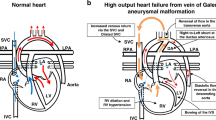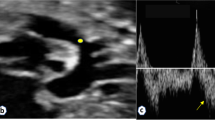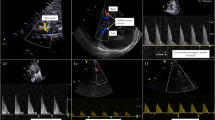Abstract
Objective:
To examine hemodynamic changes following endovascular embolization in newborn infants with vein of Galen malformation and severe cardiac failure in the first week of life.
Study design:
Over a recent 5-year period, nine such infants were identified. In seven of these infants, changes in arterial blood pressure were analyzed in relation to the timing of embolization procedures.
Results:
A significant increase in arterial blood pressure was noted after most embolizations. In two infants, this systemic hypertension was severe and treated using intravenous antihypertensive drugs. Both infants subsequently developed complete infarction of both cerebral hemispheres with sparing of the brainstem and cerebellum. Mortality in the nine infants was 33%, and 83% of the survivors were neurologically normal or near normal at follow-up.
Conclusion:
The systemic hypertension observed following endovascular embolizations may provide a protective mechanism to maintain cerebral blood flow after reperfusion injury. Lowering blood pressure in this situation may therefore be detrimental.
This is a preview of subscription content, access via your institution
Access options
Subscribe to this journal
Receive 12 print issues and online access
$259.00 per year
only $21.58 per issue
Buy this article
- Purchase on Springer Link
- Instant access to full article PDF
Prices may be subject to local taxes which are calculated during checkout



Similar content being viewed by others
References
Lasjaunias P . Vein of Galen aneurysmal malformation. In: Lasjaunias P, terBrugge K (eds). Vascular Diseases in Neonates, Infants and Children. Springer Verlag: Berlin, Heidelberg, New York, 1997, pp 67–136.
De Victor D, Le Pommelet C . Medical treatment of congestive cardiac failure from cerebral arteriovenous fistulas at Bicetre Hospital. Interv Neuroradiol 1996; 2: 49–52.
Garcia-Monaco R, De Victor D, Mann C, Hannedouche A, Terbrugge K, Lasjaunias P . Congestive cardiac manifestations from cerebrocranial arteriovenous shunts. Endovascular management in 30 children. Child's Nerv Syst 1991; 7: 48–52.
Patton DJ, Fouron J-C . Cerebral arteriovenous malformation: prenatal and postnatal central blood flow dynamics. Pediatr Cardiol 1995; 16: 141–144.
Davis A, Menahem S . Retrograde flow in the distal aortic arch and proximal descending aorta – a clue to presence of major cerebral arteriovenous malformation. Cardiol Young 1993; 3: 161–163.
Cumming GR . Circulation in neonates with intracranial arteriovenous fistula and cardiac failure. Am J Cardiol 1980; 45: 1019–1024.
Grossman RI, Bruce DA, Zimmerman RA, Goldberg HI, Bilaniuk LT et al. Vascular steal associated with vein of Galen aneurysm. Neuroradiology 1984; 26: 381–386.
Frawley GP, Dargaville PA, Mitchell PJ, Tress BM, Loughnan P . Clinical course and medical management of neonates with severe cardiac failure related to vein of Galen malformation. Arch Dis Child Fetal Neonatal Ed 2002; 87: F144–F149.
Gailloud P, O’Riordan DP, Burger I, Levrier O, Jallo G, Tamargo RJ et al. Diagnosis and management of vein of Galen aneurysmal malformations. J Perinatol 2005; 25: 542–551.
Mitchell PJ, Rosenfeld JV, Dargaville P, Loughnan P, Ditchfield MR, Frawley G et al. Endovascular management of vein of Galen aneurysmal malformations presenting in the neonatal period. Am J Neuroradiol 2001; 22: 1403–1409.
Chevret L, Durand P, Alvarez H, Lambert V, Caeymax L, Rodesch G et al. Severe cardiac failure in newborns with VGAM. Prognosis significance of hemodynamic parameters in neonates presenting with severe heart failure owing to vein of Galen arteriovenous malformation. Intens Care Med 2002; 28: 1126–1130.
Bohn D . Congenital diaphragmatic hernia. Am J Respir Crit Care Med 2002; 166: 911–915.
Fullerton HJ, Aminoff AR, Ferriero DM, Gupta N, Dowd CF . Neurodevelopmental outcome after endovascular treatment of vein of Galen malformations. Neurology 2003; 61: 1386–1390.
Lasjaunias P, Alvarez H, Rodesch G, Garcia-Monaco R, terBrugge K, Burrows P et al. Aneurysmal malformations of the vein of Galen. Follow-up of 120 Children treated between 1984–1994. Interventional Neuroradiology 1996; 2: 15–26.
Rodesch G, Hui F, Alvarez H, Tanaka A, Lasjaunias P . Prognosis of antenatally diagnosed vein of Galen aneurysmal malformations. Child's Nerv Syst 1994; 10: 79–83.
Friedman DM, Verma R, Madrid M, Wisoff JH, Berenstein A . Recent improvement in outcome using transcatheter embolization techniques for neonatal aneurysmal malformations of the vein of Galen. Pediatrics 1993; 91: 583–586.
Taylor W, Lasjaunias P . Cerebral arteriovenous shunts in children: some aspects of presentation and treatment. Imaging 1996; 8: 141–157.
Fellman V, Raivio KO . Reperfusion injury as the mechanism of brain damage after perinatal asphyxia. Pediatr Res 1997; 41: 599–606.
Ayata C, Ropper AH . Ischemic brain oedema. J Clin Neurosci 2002; 9: 113–124.
Boylan GB, Young K, Panerai RB, Rennie JM, Evans DH . Dynamic cerebral autoregulation in sick newborn infants. Pediatr Res 2000; 48: 12–17.
Rosenbaum JL, Almli CR, Yundt KD, Altman DI, Powers WJ . Higher neonatal cerebral blood flow correlates with worse childhood neurologic outcome. Neurology 1997; 49: 1035–1041.
Pryds O, Edwards AD . Cerebral blood flow in the newborn infant. Arch Dis Child Fetal Neonatal Ed 1996; 74: F63–F69.
O’Connell J, Gray CS . Treating hypertension after stroke. BMJ 1994; 308: 1523–1524.
Blood Pressure in Acute Stroke collaboration (BASC). Interventions for deliberately altering blood pressure in acute stroke. Cochrane Database Sys Rev 2001; 2: (CD000039).
Adams Jr HP, Brott TG, Crowell RM, Furlan AJ, Gomez CR, Grotta J et al. AHA Medical/Scientific statement: special report: guidelines for the management of patients with acute ischaemic stroke. Circulation 1994; 90: 1588–1601.
Castillo J, Leira R, Garcia MM, Serena J, Blanco M, Davalos A . Blood pressure decrease during the acute phase of ischemic stroke is associated with brain injury and poor outcome. Stroke 2004; 35: 520–526.
Brott T, Bogousslavsky J . Treatment of acute ischemic stroke. N Engl J Med 2000; 343: 710–722.
Oliveira-Filho J, Silva SC, Trabuco CC, Pedreira BB, Sousa EU, Bacellar A . Detrimental effect of blood pressure reduction in the first 24 h of acute stroke onset. Neurology 2003; 61: 1047–1051.
Rordorf G, Cramer SC, Efird JT, Schwamm LH, Buonanno F, Koroshetz WJ . Pharmacological elevation of blood pressure in acute stroke. Clinical effects and safety. Stroke 1997; 28: 2133–2138.
McKinstry RC, Miller JH, Snyder AZ, Mathur A, Schefft GL, Almli CR et al. A prospective, longitudinal diffusion tensor imaging study of brain injury in newborns. Neurology 2002; 59: 824–833.
Acknowledgements
We are grateful to the Newborn Emergency Transport Service, Victoria, Australia. They provided the technological support to move these critically ill infants between the two hospitals for endovascular procedures. We also thank Professor Adrian Walker at the Ritchie Centre for Baby Health Research, Monash University, Melbourne, Australia, for his assistance with the statistical analysis.
Author information
Authors and Affiliations
Corresponding author
Rights and permissions
About this article
Cite this article
Wong, F., Mitchell, P., Tress, B. et al. Hemodynamic disturbances associated with endovascular embolization in newborn infants with vein of Galen malformation. J Perinatol 26, 273–278 (2006). https://doi.org/10.1038/sj.jp.7211479
Received:
Accepted:
Published:
Issue Date:
DOI: https://doi.org/10.1038/sj.jp.7211479
Keywords
This article is cited by
-
Pulmonary hypertension associated with vein of Galen malformation. Fetal cardiac hemodynamic findings and physiological considerations
Journal of Perinatology (2022)
-
Neurogenic stunned myocardium after embolization in two children with vein of Galen aneurysmal malformation
Neuroradiology (2013)
-
Hemodynamic disturbances associated with endovascular embolization
Journal of Perinatology (2006)



